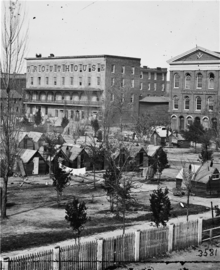
The Battle of Ezra Church, also known as the Battle of Ezra Chapel and the Battle of the Poor House saw Union Army forces under Major General William T. Sherman fight Confederate States Army troops led by Lieutenant General John B. Hood in Fulton County, Georgia during the Atlanta campaign in the American Civil War. Sherman sent Oliver Otis Howard's Union Army of the Tennessee circling around the west side of Atlanta with the purpose of cutting the Macon and Western Railroad. Hood countered the move by sending two corps commanded by Stephen D. Lee and Alexander P. Stewart to block the move. Before Howard's troops reached the railroad, the Confederates launched several attacks on them that were repulsed with heavy losses. Despite the tactical defeat, the Confederates prevented their foes from blocking the railroad.

Sope Creek is an 11.6-mile-long (18.7 km) stream located in Cobb County, Georgia, United States. It is a significant tributary of the Chattahoochee River. It was known as Soap Creek during the 19th century. A section of Sope Creek runs through the Chattahoochee River National Recreation Area.

Built in phases between 1984 and 1991, the Concourse at Landmark Center is a real estate development in metro Atlanta's Perimeter Center business district, in the city of Sandy Springs, Georgia, United States. It is a 70 acre planned community with two 34-story office towers, several low-rise office buildings, a hotel, and a health club, all set in landscaped grounds around a man-made lake.
The Kimball House was the name of two historical hotels in Atlanta, Georgia. United States. Both were constructed on an entire city block at the south-southeast corner of Five Points, bounded by Whitehall Street, Decatur Street, Pryor Street, and Wall Street, a block now occupied by a multi-story parking garage.
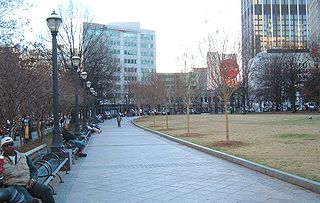
Woodruff Park, named for Robert W. Woodruff, is located in the heart of Downtown Atlanta, Georgia. The park's 6 acres (2.4 ha) are north of Edgewood Ave, between Peachtree Street NE and Park Place NE. The park includes a fountain, a performance pavilion, and several monuments.
The Roxy Theatre was a movie palace in Atlanta, Georgia. It was notable for showcasing the original Atlanta runs of such films as Spartacus, the 1962 The Music Man, the Technicolor Mutiny on the Bounty with Marlon Brando, and My Fair Lady. It was torn down in 1972 to make way for the Westin Peachtree Plaza, the hotel that was prominently featured in the 1981 film Sharky's Machine. It should not be confused with the Coca-Cola Roxy Theatre, originally the Buckhead Theatre, a different building in Buckhead. The Buckhead Theatre subsequently became the Capri Theatre and later closed, re-opening in 2010 under its original name Buckhead Theatre.
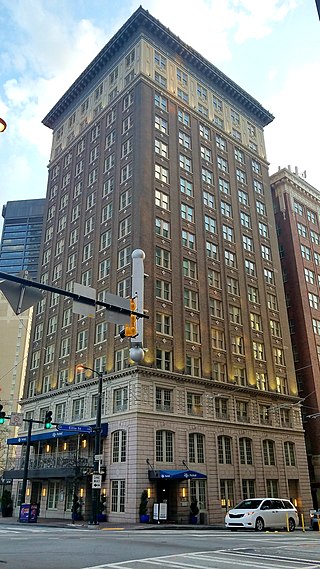
The Ellis Hotel, formerly known as the Winecoff Hotel, is located at 176 Peachtree Street NW, in downtown Atlanta, Georgia, USA. Designed by William Lee Stoddart, the 15-story building opened in 1913. It is located next to 200 Peachtree, which was built as the flagship Davison's. It was listed on the National Register of Historic Places on March 31, 2009. The Ellis Hotel is best known for a fire that occurred there on December 7, 1946, in which 119 people died.

The Hotel District is a neighborhood in Downtown Atlanta, Georgia, United States. The district's name is derived from it being the home to many hotels, one of them being the famous Westin Peachtree Plaza Hotel. The Hotel District is generally considered to be bounded by the Downtown Connector to the east, Five Points to the south, Centennial Olympic Park to the west, and Midtown to the north. The district's primary thoroughfare is Peachtree Street, which contains most of the restaurants, hotels, and office buildings. The intersection of Andrew Young International Boulevard and Peachtree Street forms the heart of the district.

South Downtown is a historic neighborhood of Downtown Atlanta, Georgia, United States. South Downtown is primarily home to city, county, state, and federal governmental offices, which prompted the city to adopt signage declaring the area "Government Walk." Although much of South Downtown is dominated by surface parking lots, the neighborhood was passed over during the redevelopment boom of the 1960s and 1970s that resulted in the demolition of much of Downtown's architecturally significant buildings. The result is myriad buildings from the 1950s and earlier that retain their historic structural integrity.
Alex Cooley's Electric Ballroom was a music venue located in Atlanta, Georgia that existed between 1974 and 1979. The original owners were Alex Cooley and Mark Golob. It was located in the Grand Ballroom of the Georgian Terrace Hotel at 663 Peachtree Street NE. It became the Agora Ballroom before closing in 1983. The structure burned down in 1987.
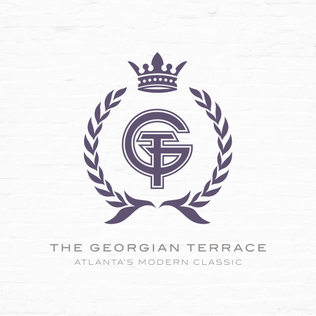
The Georgian Terrace Hotel in Midtown Atlanta, part of the Fox Theatre Historic District, was designed by architect William Lee Stoddart in a Beaux-Arts style that was intended to evoke the architecture of Paris. Construction commenced on July 21, 1910, and ended on September 8, 1911, and the hotel opened on October 2, 1911. The George C. Fuller Construction Company was contractor, and the developer was Joseph F. Gatins, Jr.
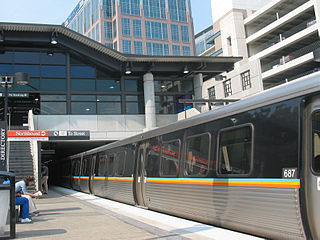
Lindbergh, officially Lindbergh/Morosgo, is a neighborhood in the Buckhead district of Atlanta, Georgia. Most of the neighborhood consists of multi-use development combining retail, office and residential space.
The Atlanta Hotel also known as Thompson's Hotel, was one of the original hotels in antebellum Atlanta, Georgia. It stood at the northwest side of State Square, pre-war Atlanta's central square, on the northwest side of Pryor Street between Decatur Street and what is now Wall Street.

State Square was the central square of antebellum Atlanta, Georgia. The original Atlanta Union Depot designed by Edward A. Vincent stood in the middle of the square. The square was bounded by Marietta Street on the northeast, Pryor Street on the northwest, Loyd Street on the southeast, and Alabama Street on the south. The square was surrounded by Atlanta's most important buildings including the hotels Atlanta, Trout House, and Washington Hall, the Atlanta Bank, retail stores, and warehouses.

Atlanta's second Union Station was built in 1871 on the site of the 1853 station, burned in mid November 1864 when Federal forces left Atlanta for the March to the Sea. It was built in Second Empire style, designed by architect Max Corput. It was located at what is now Wall Street between Pryor Street and Central Avenue.
Washington Hall was a historic hotel in antebellum Atlanta, Georgia. Built in 1846, the building was one of the earliest hotels built in the city. The hotel, along with many other structures in the city, was destroyed in 1864 during the Battle of Atlanta.

The Hotel Ansley was a hotel that occupied the south side of Williams Street between Forsyth and Fairlie streets in the Fairlie-Poplar district of Downtown Atlanta. It was built in 1913 by Jerome B. Pound of Chattanooga, TN and named for Edwin P. Ansley, developer of the Ansley Park neighborhood; an estimated 5000 guests attended the opening of the $1,000,000 property. The property was originally managed by M.I. and Frank Harrell.

The Hotel Aragon was a six-story, 125-room hotel at 169 Peachtree Street NE, at the southeast corner of Ellis Street in Atlanta, in what is today the Peachtree Center area of downtown. It was a major addition to the city's hotel capacity at its completion in 1892, cost $250,000, and was built and owned by George Washington Collier. It was the only major hotel in the city not adjacent to Union Station. A 1902 guidebook describes the Aragon as one of three first-class hotels in the city, together with the Kimball House and the Majestic Hotel.

The Leyden House was one of Atlanta's most historic homes. It was located on 124 Peachtree Street NE between Cain and Ellis streets.

The Eugene Talmadge statue is a public monument located on the grounds of the Georgia State Capitol in Atlanta, Georgia. Designed by Steffen Thomas, the statue was unveiled in 1949 and depicts Georgia Governor Eugene Talmadge. The statue has been the subject of recent controversy given Talmadge's white supremacist and racist views.
